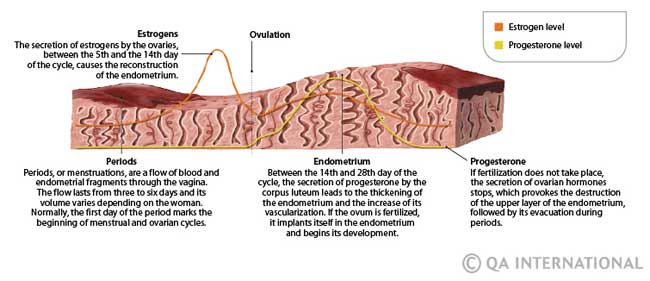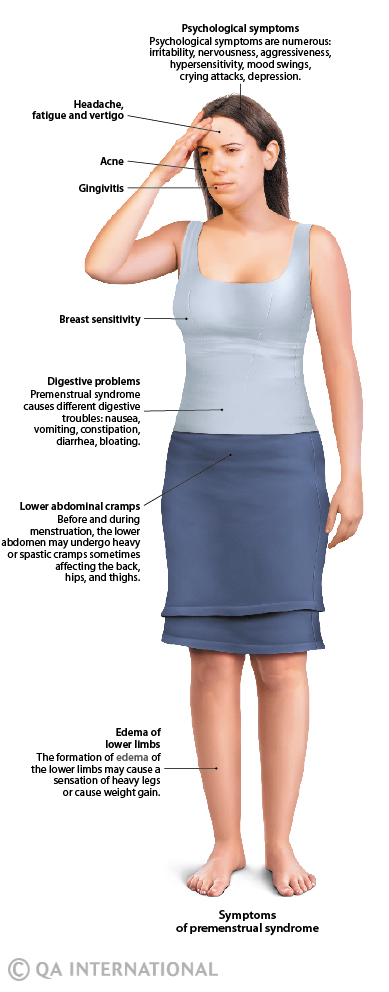
The menstrual cycle or the circle of life
In order for a potential fertilized ovum to attach itself to the mucous membrane of the uterus, the uterus periodically undergoes a series of transformations called the menstrual cycle. This cycle is governed by the hormones produced by the ovaries and the pituitary gland and occurs parallel to the ovarian cycle. The menstrual cycle occurs in all healthy women, from puberty to menopause and outside periods of pregnancy. It may be accompanied by abdominal cramps, particularly during ovulation or periods. Premenstrual syndrome corresponds to various issues that affect some women during the days preceding periods.
Menstrual cycle phases
Like the ovarian cycle, the menstrual cycle lasts an average of 28 days. It is comprised of three phases: the menstrual phase, during which the endometrium sheds and flows through the vagina (periods); the proliferative phase, during which the endometrium is reconstituted, and the secretory phase, during which it thickens to accommodate the fertilized ovum. These phases, which succeed in a cyclical manner, are strictly related to hormones (estrogens and progesterone) secreted by the ovaries during the ovarian cycle.

Heavy periods
A woman suffers from menorrhagia when her periods last more than seven days and when the overabundance of the flow forces her to frequently change her menstrual protection. This trouble may be accompanied by debilitating abdominal cramps and may cause iron deficiency anemia causing fatigue and breathlessness. Menorrhagia is frequent in the approach to menopause and at the beginning of adolescence, periods marked by significant hormonal fluctuations that cause exaggerated development of the endometrium. More rarely, it results from disorders affecting the uterus, endometrium, ovaries, etc. Ectopic pregnancy and miscarriage also provoke copious vaginal bleeding, but outside the menstrual period.
Premenstrual syndrome
In some women, the hormonal changes of the ovarian cycle may cause several physical and psychological issues a few days before and sometimes at the beginning of periods. Called premenstrual syndrome (PMS), these varying symptoms affect 5% to 10% of women in a severe and highly debilitating manner. Though some PMS-like symptoms can manifest starting from puberty, premenstrual syndrome appears generally around age 30, particularly in women having familial antecedents and in those who suffer from stress, anxiety, or depression. In some women, pain in the lower abdomen persists and intensifies during menstruation. This disorder, called dysmenorrhea, is frequent in adolescence. It generally decreases with age and often after pregnancy. Even if it often results from hormonal factors, dysmenorrhea can sometimes reveal an anomaly in reproductive organs: endometriosis, infection, tumor, etc.

Absence of periods
The absence of periods, or amenorrhea, is said to be primary when a woman has not yet had a period after the age of 16. It generally results from a genetic or anatomical anomaly. Amenorrhea is secondary if a woman who normally has her period has not had a period for three consecutive cycles. It may be caused by pregnancy, chemotherapy, or illness: tuberculosis, kidney failure, hypophyseal adenoma, anorexia, etc. It can also be linked to the intensive practice of sports or have a psychological origin. After 40, amenorrhea associated with other characteristic signs leads to the diagnosis of menopause, which may be confirmed by a test that assesses the level of sex hormones in the blood. In younger women, secondary amenorrhea may also be the sign of premature menopause.
Alleviating menstrual pains
Some measures may contribute to the relief the various discomfort that arises before and after periods, notably cramps in the lower abdomen, back pain, and edema in the legs. However, if the symptoms are particularly intense or irregular, a doctor should be consulted.
Exercise
Exercising regularly (walking, swimming) is beneficial in preventing or relieving symptoms related to periods. To minimize abdominal cramps, you can also adopt yoga stances like the arch or the cobra.
Attention! If you have any health problems, consult your doctor before beginning a physical exercise program. Some positions may be contraindicated. If a position or movement causes pain, stop practicing it.
Make yourself warm
As heat can minimize lower abdominal cramps, take a hot bath or apply a hot water bottle to your abdomen. If these methods are not effective, you can, alternatively, apply a bag of ice to your abdomen for 15 minutes.
Rest and relax
Before and during menstruation, do not hesitate to rest and practice relaxing activities: deep and regular breathing through the abdomen, massaging painful areas, etc.
Adapt your diet
Your diet must be balanced, rich in fruits and vegetables. Also, the consumption of food rich in unsaturated fatty acids, like fatty fish (salmon, mackerel, etc.), vegetable oils, grains, etc., is encouraged. A good calcium source, especially present in dairy products, would also be beneficial. Limit your consumption of salt and stimulants like alcohol, coffee, tea, spices, sugar products, and saturated fats (red meat, whole milk products, etc.).
Take medication when needed
Non-steroidal anti-inflammatories like ibuprofen can minimize pain and discomfort related to periods. If they are not effective, a doctor can prescribe different treatments to block ovulation and others adapted to different symptoms: diuretic medication, antispasmodics, anxiolytics,etc.
Also see:
In the Visual Dictionary:
- "human being" section
In the encyclopedic capsules:
- Menopause
- Childbirth
- Adolescence
- Hormones: the body’s chemical messengers
- Touch Therapy
- Cancer: causes and prevention
- A balanced diet
- Hygiene and the prevention of infections
In the ikonet games:
- Put it in its place!: Composition of the blood , Uterus posterior view




